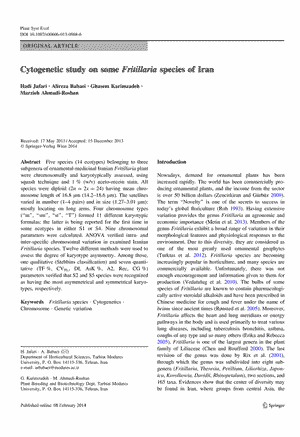NEWS 2014
The Cytogenetic study on some Fritillaria species of Iran
Hadi JAFARI¹, Alireza BABAEI¹, Ghasem KARIMZADEH², Marzieh AHMADI-ROSHAN²
Plant Systematics and Evolution (2014)
doi: 10.1007/s00606-013-0968-6
¹Department of Horticultural Science, Tarbiat Modares University, P. O. Box 14115-336, Tehran, Iran
²Plant Breeding and Biotechnology Dept., Tarbiat Modares University, P. O. Box 14115-336, Tehran, Iran
Abstract
Five species (14 ecotypes) belonging to three subgenera of ornamental-medicinal Iranian Fritillaria plant were chromosomally and karyotypically assessed, using squash technique and 1 % (w/v) aceto-orcein stain. All species were diploid (2n = 2x = 24) having mean chromosome length of 16.8 μm (14.2–18.6 μm). The satellites varied in number (1–4 pairs) and in size (1.27–3.01 μm): mostly locating on long arms. Four chromosome types (“m”, “sm”, “st”, “T”) formed 11 different karyotypic formulas: the latter is being reported for the first time in some ecotypes in either S1 or S4. Nine chromosomal parameters were calculated. ANOVA verified intra- and inter-specific chromosomal variation in examined Iranian Fritillaria species. Twelve different methods were used to assess the degree of karyotype asymmetry. Among those, one qualitative (Stebbins classification) and seven quantitative (TF %, CVTL, DI, AsK %, A2, Rec, CG %) parameters verified that S2 and S5 species were recognized as having the most asymmetrical and symmetrical karyotypes, respectively.

